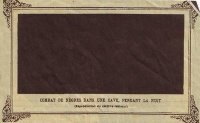Color
From The Art and Popular Culture Encyclopedia
| Revision as of 17:06, 5 February 2015 Jahsonic (Talk | contribs) ← Previous diff |
Revision as of 08:27, 25 June 2015 Jahsonic (Talk | contribs) Next diff → |
||
| Line 18: | Line 18: | ||
| *[[Grue]] | *[[Grue]] | ||
| *[[The Missing Shade of Blue]] | *[[The Missing Shade of Blue]] | ||
| + | *''[[Theory of Colours]]'' | ||
| {{GFDL}} | {{GFDL}} | ||
Revision as of 08:27, 25 June 2015

Illustration: Negroes Fighting in a Tunnel at Night (1882) by Paul Bilhaud, here shown in the 1887 version appropriated by Alphonse Allais as published in Album primo-avrilesque (April fool-ish Album)
|
Related e |
|
Featured: |
Color or colour is the visual perceptual property corresponding in humans to the categories called red, yellow, blue, black, etc.
Typically, only features of the composition of light that are detectable by humans (wavelength spectrum from 400 nm to 700 nm, roughly) are included, thereby objectively relating the psychological phenomenon of color to its physical specification. Because perception of color stems from the varying sensitivity of different types of cone cells in the retina to different parts of the spectrum, colors may be defined and quantified by the degree to which they stimulate these cells. These physical or physiological quantifications of color, however, do not fully explain the psychophysical perception of color appearance.
The science of color is sometimes called chromatics. It includes the perception of color by the human eye and brain, the origin of color in materials, color theory in art, and the physics of electromagnetic radiation in the visible range (that is, what we commonly refer to simply as Light).
See also
- Distinction of blue and green in various languages
- Couleur locale
- List of colors
- Synaesthesia
- Grue
- The Missing Shade of Blue
- Theory of Colours

_-_Seurat.jpg)

